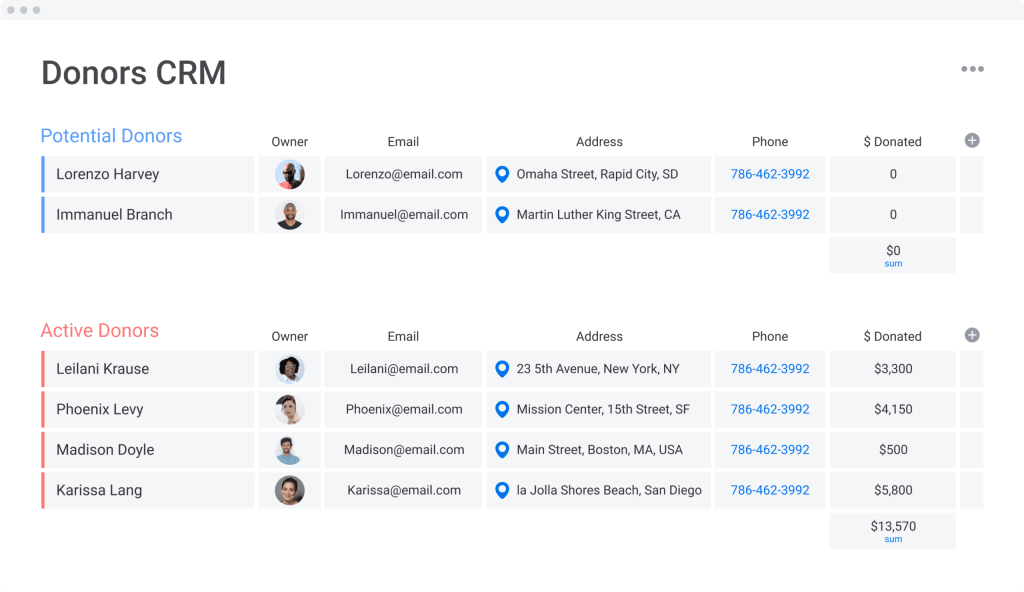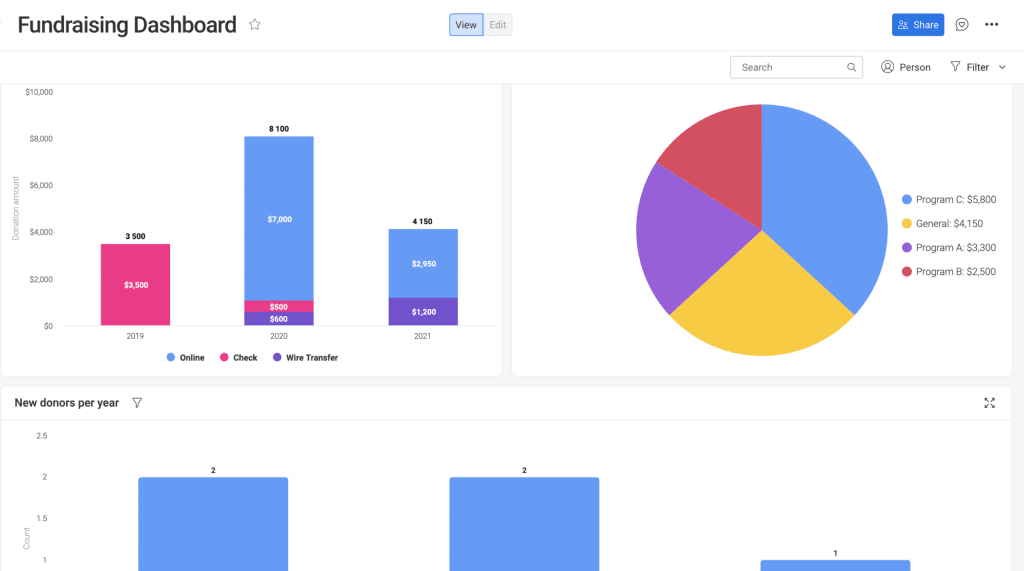As a nonprofit, it is important to raise money to keep things afloat and work towards your mission. One of the best and most significant ways to receive donations is through fundraising, and to do this you need a fundraising plan.
A fundraising strategic plan details key goals related to donor acquisition, fundraising calendars, donor retention, and more. It is a critical tool for getting everyone on the same page — including board members and potential donors — and working towards a common goal and this is essential to the success of your cause.
What is a fundraising plan?
A fundraising plan is a document that highlights your fundraising goals and strategies and how you hope to achieve them. It’s basically a roadmap for staff members to follow and helps you track and measure your progress throughout the course of the year. The plan typically includes:
- Key dates and timelines
- Campaigns and events
- Fundraising activities
- Objectives of each event and campaign
- Roles for fundraisers
A great way to make sure you include all the essentials each time is to use or create a fundraising plan template. You can create one in minutes on monday.com Work OS using our Template Center. With a set structure in place, you can help avoid distractions and losing sight of priorities along the way.
That said, your plan should be flexible enough to update whenever the need arises. Things change and your plan must be able to accommodate those changes. You don’t want to lose out on incredible opportunities simply because it’s not part of your fundraising strategy. monday.com gives you the ability to quickly pivot and make updates and changes in real-time so everyone is on the same page.

How to write a strategic fundraising plan
If you’ve started on any type of strategic plan for your organization, chances are you already have the skills to put together a proper fundraising plan that can yield results. A fundraising plan should do more than just outline fundraising ideas. It should detail everyone’s role and tasks, as well as the objectives of each task. A fundraising strategy helps organizations get aligned and brings everyone together, set the course, and keeps everyone in the same direction. A fundraising plan works best when everyone is involved in its creation, from staff members to stakeholders. While having everyone contribute is a good way to put ideas to paper, delegate a few key people to compile and structure the plan in the most effective way. It helps to get insights from everyone in the organization but stick to just a few people to actually work on the strategy once all ideas have been finalized.
To begin the planning process, invite all parties to share their input and be involved in raising funds for your organization. Consider it a group project. Share your goals and budget with the team and work together on a strategic plan for the next six to 12 months. Also, use fundraising results from the previous year as the benchmark so everyone knows where the organization stands in terms of funding and what the future prospects are.
If everyone understands what needs to be done and how to get there, it will be easier to achieve your goals as a unit. Remember to identify the key decision-makers, but get everyone involved in the process.
Questions to consider when creating a fundraising plan
There are a few questions to consider when mapping out your fundraising plan example. This will help you put together a skeleton, which can be fleshed out more as you go. Some questions to ask yourself are:
- What past strategies have been most successful for fundraising? Why was it successful and what were the challenges?
- What do our donors want to see from our organization? What type of messaging do they respond to?
- What opportunities are available?
- What fundraising campaigns have not worked and why?
- What do we have to work on to improve our strategy?
- What do we have to avoid?
- What are the risks involved in trying something new?
The value of asking these questions is that the discussion will extend beyond the plan you want to create to give you a broader view of your fundraising efforts, how to improve and what the potential obstacles could be. It also sets the tone for what the project entails, expectations, and conversations around fundraising.
6 steps to create a fundraising plan
There are a variety of reasons why you should implement a proper fundraising plan. This plan will ensure that you and your team are held accountable with a range of benchmarks via the process. Below are the steps:
1. Take a look at your past finances
Whenever you begin developing a new fundraising strategy, you must first examine your current financial situation. This allows you to extract critical insights from the data, such as how your firm has evolved in the last year and where you will see it heading in the future. Pay close attention to where your campaign income has come from before so that you may include it into your future plans, such as:
- Major donors: The meaning of a major donation varies widely from organization to charity. A few thousand dollars can be considered a substantial donation for a tiny nonprofit, but bigger companies consider major gifts to be in the six-figure range. Regardless of the criterion, the top 12% of contributors account for an average of 88 percent of individual donor funds.
- Corporate giving: Businesses and companies are the last source of fundraising funds for many charitable groups. A large portion of this money comes from charity programs, in which employers financially match their workers’ large contributions to approved charitable groups.
- Individual small- and mid-level donors: These are the bulk of donors, with donations spanning from a few dollars to over several thousand dollars. If your charity has a large number of small and mid-level contributors, you may want to focus on increasing repeat or repeating contributions.
- Corporate giving: Companies and businesses are the last source of campaign funds for many charitable groups. A large portion of this money comes from matching gift programs, in which employers financially match their workers’ generous donations to approved charitable groups.
- Nonprofit grants: If your agency has previously relied on grant financing, you are aware that this may be a terrific source of cash to jumpstart a new venture or endeavor.

2. Define your idea
To improve your fundraising approach, you must first have a good knowledge of who you are as an institution. It would be difficult to engage with donors and acquire appropriate money if your nonprofit’s goal was not clearly specified and communicated.
Even though your organization has been there for a while and you have a strong concept of where you’re from and what you do, outlining another one at the start of your planning stage may be quite beneficial. This will keep your purpose, vision, and values at the forefront of your mind while you plan and achieve your fundraising objectives.
3. Look at new trends
Making sure you’re up to date on any developing fundraising patterns in the nonprofit field is a vital component of fundraising. Staying current will allow you to engage with your intended audience more effectively and promote fresh donations.
You will also have a better idea of the various ways you may connect with your contributors and cultivate strong relationships with every one of your supporters if you take note of recent trends and keep an eye out for any others while developing your fundraising plan. Once you can integrate new ideas into your plan, you may be able to attract a new market and build your donations.
4. Establish goals
Establishing fundraising objectives for the entire year might help you stay on target. Goals may assist you and your team remember your primary goal, support efficient prioritizing, and stay on track with your entire strategy. Begin by developing a single overall aim that is consistent with the mission of your company. Then, narrow it down into a few short-term goals that will assist you in achieving the larger one.
These minor goals do not have to be directly tied to fundraising, but they should be in line with your purpose and overall aim. They can be connected to employing additional employees to meet other aims, changing your fundraising efforts, or changing the structure of your company.
5. Grow your network
Whatever your objectives are, you most certainly have a few that revolve on increasing your fanbase and generating fresh donations. Return to the previous part, where we covered analyzing your past finances, and take a close look at where the majority of your new revenue comes from, using this to influence your future goals.
For instance, if you raised the majority of your finances from individual contributors and it didn’t cost very much to implement, highlight your efforts again here. You can opt to focus on those who have previously indicated an interest in your charity but have yet to submit their first gift, or you can start from scratch and present yourself to fresh possibilities.
6. Remember donor stewardship
While obtaining new contributors is a crucial component of fundraising, acknowledging and cultivating existing supporters is just as important. Examine your existing retention rates – are your contributors staying with you for years or abandoning you as quickly as they receive their one and only tax rebate?
A strong donor stewardship program is required for your organization to boost its retention rates. If you don’t already have one, include it into your fundraising strategy and create some goals around it. Donor stewardship extends much beyond simply sending a letter of thanks and a tax certificate after a contribution is made.
Consider what you’ll do to retain the donor, create a connection with them, keep them updated on the effect of their donation, and retain existing donors each year.
Choose the right nonprofit software to build your fundraising plan
To ensure your fundraising plan is actionable and results-driven, you have to make your objectives and strategies clear and achievable. It also has to be effective to achieve your desired goals. Consider what people, systems, and processes are necessary to get your plan off the ground. You don’t want it gathering dust. You want a plan that can be put into action.
That said, the nonprofit fundraising software you use can influence the way to create your nonprofit development plan. If you use a donor management system, you can focus on donor journeys and how best to communicate and engage with them. If you’re using a nonprofit CRM, you can take a more responsive approach to fundraise for the best results.
monday.com fundraising template
Ask yourself what software you need to get the ball rolling and what features best suit your organization. monday.com’s fundraising template is an easy-to-use template and dashboards to help you maximize your fundraising efforts and make the most impact. The template is designed to simplify and streamline your operations in one convenient location, while intuitive features and integrations let you customize and track all your efforts in real-time so you don’t get left behind.
With this template you can meet your fundraising goals faster, plan, track and launch campaigns, engage with donors and create targeted communications to your supporters to help start your journey to success.

